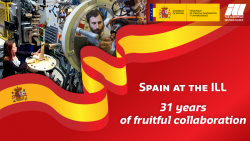Spain set to solve grand energy challenges with neutron science
Since Spain became a Scientific Member of ILL in 1987, neutron research has grown beyond expectation in the country. Without its own neutron source, Spanish industry and researchers have looked to the ILL, founded over 50 years ago, for its exceptional hands-on expertise and state-of-the art instruments, to drive the next generation of scientific discoveries. Spanish researchers have used neutrons to advance more sustainable energy solutions. Neutron techniques have allowed researchers to take a closer look at hydrogen, a promising renewable energy resource, and how the different components of a fuel cell behave, paving the way to a hydrogen-powered future. Scientists are also increasing our understanding of how rocks under the Earth’s surface can feed into a greener energy infrastructure. This involves analysing how fossil fuel gases might be recuperated from underground without affecting the complex equilibrium in the rock. This will also help us to understand how carbon dioxide might be stored in rocks in future. The country has built a neutron research community from scratch and continued to grow and improve the standards of neutron science. From just three specialists on the subject in the 1980s, when the Spanish Ministry of Education and Science signed its first agreement with the ILL, Spain now has closer to 300 neutron scientists. Publications on neutron scattering techniques are now growing twice as fast as any other scientific research more generally in the country. This is as Spain has taken hold of the opportunity for discovery and achieved a strong position in the global neutron community; publishing more than 200 papers per year, it is one of the most active European countries in the field. Spanish academia and industry has had access to exceptional hands-on expertise and some 40 state-of-the art instruments at ILL, with 12.5% of industry applications for beam-time on the ILL’s specialist SALSA instrument in 2018 from Spain and over 5% of the neutron beam-time overall for scientific projects at the facility dedicated to the country. Companies like TRIO Aerospace have used ILL’s facilities to help make processes more efficient. For instance, this year CATEC-Sevilla (Center for Advanced Aerospace Technologies) specifically drew on SALSA strain diffractometer capabilities and expertise to study the residual stresses on 3D-printed aluminum hardware for satellites, with further activities planned for 2019, including a master thesis for texture and stress characterisation with SALSA. The future looks bright for neutron research in Spain, as ILL continues to upgrade its capabilities to meet the changing demands of users. Researchers from the country have been heavily involved in the development of the XTREMD instrument with ILL experts a new diffractometer designed specifically for extreme conditions, which will provide new exciting opportunities for scientists studying pressure and magnetic field. Professor Helmut Schober, Director of the ILL, said: “Ensuring access to the facility has been extremely important for Spain as the neutron resources at ILL cannot be found elsewhere. We have had a fruitful 31 years collaborating with Spanish industry and academia and the country’s membership of the ILL has seen Spain become a base for neutron scattering specialists, opening the door for novel research lines. ILL has helped Spanish companies through all stages of their innovation journey, from investigating initial R&D materials and processes, through product and process R&D to failure analysis. In return, Spain has helped ILL maintaining its outstanding scientific excellence.” More on: www.ill.eu/181128_Spain
Keywords
Neutron, Neutron spectroscopy, European Research Area, Research Infrastructure
Countries
Spain



